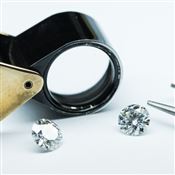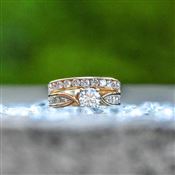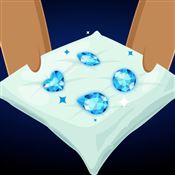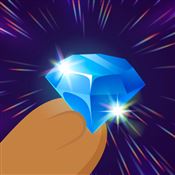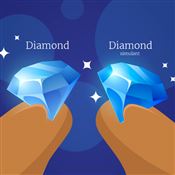Marquise Diamond
Marquise diamonds are unique and offer more value for your buck. But there are some things to watch out for when choosing a quality marquise. Read on to learn about this rare cut.
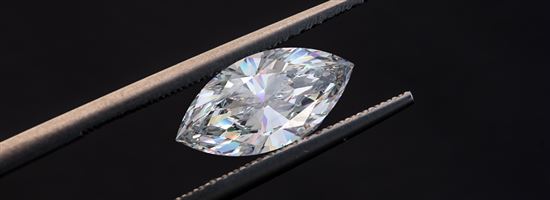 |
What Is a Marquise Diamond?
The marquise diamond resembles a football with its oval cut and pointed ends. It has the standard 58 facets that you find on other cuts.
Typically, marquise diamonds have:
- 33 facets on the crown
- 25 facets on the pavilion (bottom)
A common nickname for the stone is the "navette," which means little boat in French. Indeed, these diamonds resemble the features of a small boat.
Pros & Cons
Here are some reasons you may like or dislike the marquise cut:
PROS
- It looks huge: A marquise diamond appears the largest of all cuts (of the same carat weight). It has a larger surface area compared to other diamond shapes.
- More affordable: Marquise diamonds usually cost less compared to round diamonds. Combined with the larger appearance, this means you can get a bigger-looking diamond for less.
- Flattering: Because of its shape, the marquise diamond elongates the fingers. It's flattering on those with small or short fingers.
- Hide flaws: The brilliant cut of the marquise diamond allows it to hide certain flaws, or inclusions. So you can save some money by purchasing a lower clarity diamond.
- Unique: The marquise cut is unique and rarely seen on the ring fingers of brides. It's good if you want to stand out. Plus, it's versatile and looks good in a variety of ring settings.
CONS
- Dark spots: Marquise diamonds often exhibit a "bow tie" effect. This is a black or grey shadow in the shape of a bow tie right in the center of the diamond. This effect is due to the shape and uneven distribution of light.
Darker and larger shadows in the diamond can detract from its beauty.
- Yellow tips: Marquise diamonds tend to trap more yellow tint at the pointed tips. Even more so with larger carats. This means you may not be able to sacrifice too much on color.
- Chipping: The pointed edges of the diamond are more susceptible to chipping if hit just right. It's best if the diamond has V-shaped prongs to protect the tips.
If your marquise diamond has inclusions at the points (particularly internal cracks), they can weaken the diamond.
But V-shaped prongs at the tips can help hide the flaws and give your diamond the protection it needs.
Marquise Diamond Characteristics
Cut, color, and clarity affect different diamond cuts in different ways. This means that each shape requires special characteristics to get the best sparkle.
To pick the best marquise diamond, here's what you need to know.
Cut
While the GIA doesn't grade a marquise's overall cut, they inspect elements of its cut quality. This includes symmetry, ratio, and more. Here's what to look for:
Symmetry
The marquise shape should be completely symmetrical. You should be able to "split" the diamond in half, with each side appearing identical.
Length to Width Ratio
The classic length-to-width ratio of a marquise diamond ranges from 1.75 to 2.15. The greater the ratio, the "skinnier" and longer the diamond. Those on the lower range look chunkier and shorter.
But while the numbers can guide you, the perfect ratio depends on your personal preference. You might prefer the longer diamonds because they look larger. Or you may like the shorter ones for their durability.
Here are three marquise diamonds with ratios of 1.78, 1.95, and 2.11. You may want to check them out to see if you like a skinnier or chunkier stone better.
Girdle Thickness
If the girdle is too thin, the diamond can more easily chip. However, if it's too thick, too much weight is in the girdle, where you can't appreciate.
- Belly: The area of the diamond with the most curve on its side. This is the area used to measure its width.
- Wing: The curved area of the diamond starting at the belly and ending at the point.
- Point: The 2 points at each end of the marquise diamond.
- Keel Line: A vertical line that travels from the top of the diamond to the bottom.
- Girdle: The edge where the top of the diamond (crown) and the bottom (pavilion) come together.
- Culet: The pointed tip at the bottom of the pavilion.
Shape Appeal
After checking the numbers, you want to make sure that the diamond actually looks good. Common problems with the shape can take away from a marquise cut's appeal.
For this, watch out for the wings and tips. Sometimes the wings look too flat (less curvy), too plump (too curvy), or uneven. For the tips, you don't want them looking rounded instead of pointed.
Cut Guidelines Table
| Excellent | Good | Poor | |
|---|---|---|---|
| Table % | 53-63 | 50-52 or 64-70 | < 50 or > 70 |
| Depth % | 58-62 | 50-57.9 or 62.1-74 | < 50 or > 74 |
| Girdle | Thin-Slightly Thick | Thin-Slightly Thick | Very Thin-Very Thick |
| L-W Ratio | 1.75-2.15 | 1.55-1.74 or 2.16-2.45 | < 1.55 or > 2.45 |
| Culet | None | Very Small-Medium | > Medium |
| Crown Height | 12%-15% | 10%-11% or 16%-17% | < 8% or > 20% |
Ideal Proportions
Here are our recommended proportions for the best light performance and minimal dark spots:
- Depth percentage: 58% - 62%
- Table percentage: 53% - 63%
- Crown height percentage: 12% - 15%
- Girdle: Very thin - slightly thick
- Culet: None
Common Marquise Cut Problems
Finding a quality marquise can be easier if you know the red flags to avoid. Here are two of the most common cut problems with marquise diamonds:
- Bowtie Effect
Almost every marquise diamond has a bowtie, or a dark spot running across its center. It happens to poorly-cut stones that can't reflect light properly.The severity varies per diamond. Sometimes it's almost invisible or even adds contrast to the sparkle. But when big enough, they can seriously ruin the stone's beauty.
Spotting bowties can be tricky since they're not listed on the certificate. That said, the best way to avoid them is by inspecting the diamond yourself.
Most online retailers show magnified videos of their diamonds. That's why shopping online can actually help you spot bowties easily. - Slender Football
Your marquise diamond will look like a dull, narrow football if its table is too small and its crown is too high. Marquises cut like this don't look as sparkly since they can't reflect light properly. Be sure that the diamond follows the ideal table and crown measurements to avoid this.
Color
Remember that marquise diamonds tend to trap more yellow tint at the tips. We recommend color H if you're setting the diamond in a white gold or platinum ring. This offers the best balance of price while still looking colorless.
If you're setting it in a yellow gold or rose gold ring, then it's safe to go down to a J in color. These slightly warmer-toned diamonds will beautifully complement the golden band and seem colorless in comparison.
For larger diamonds in a yellow or rose gold ring, an I color diamond will appear fairly colorless. However, you can stay at J if you want an overall warmer look.
Clarity
All that matters is that the diamond is eye-clean, which means that you don't see any flaws with the naked eye. VS2 diamonds are usually a safe choice and offer great value.
You may want to inspect the diamond for flaws at the points, including the type of flaw. Internal cracks at the points will put the diamond at risk for chipping. But if it's just other small flaws like a surface scratch or black crystal, you can hide those with prongs.
Carat
With a marquise diamond, you don't need to aim for the biggest carat to get an impressive rock. Its elongated body and shallow cut make it look larger than other diamond shapes of the same carat. Add the fact that it's one of the cheaper cuts and you get a bigger stone for a lower price.
So how does it end up looking larger? The stone's weight is concentrated on the crown, or the part you see face up. That's unlike deeper shapes, like round and princess, whose depth takes away from the size.
Now let's compare the dimensions of this marquise vs. this round diamond. Both weigh 1.01 carats.
1.01 carat marquise: 10.18x5.38x3.2
1.01 carat round: 6.47x6.51x3.93
That's almost 4 mm of difference in length, or 4 mm more finger coverage with the marquise diamond. And you save $400 which you can use towards a better engagement ring setting.
The Best Setting for a Marquise Diamond
Marquise diamonds are unique, and the setting should show that off. Here are some settings that work best with the marquise cut:
Solitaire:
A solitaire setting will really put the diamond at the center of attention. The setting should have 6 prongs to hold the diamond securely in place. Ideally, the pointed tips should be protected with V-shaped prongs.
Bezel:
A bezel setting has a metal rim around the diamond, protecting the diamond from all sides. This setting is contemporary and good for active women or those who work with children.
Side stones:
The marquise diamond also looks great with smaller sidestones on either side, especially triangular trillion stones. They can even be colored gemstones to make the center stone pop.
Halo:
A halo setting surrounds the diamond in a "halo" of smaller diamonds. The marquise is quite a vintage cut and this style adds a little bit of that feel. Plus, the halo gives the ring major sparkle.
Marquise Diamond Prices
Are marquise diamonds more expensive?
Marquise diamonds are cheaper than round diamonds. It can cost as much as 20% less for a diamond of the same carat, color, and clarity.
For example, a 1-carat round diamond with color H and VS2 clarity costs around $5,500. The same specs in the marquise shape cost around $4,300.
But out of the other non-round fancy shapes, the marquise cut is more expensive. Other cuts such as princess, cushion, emerald, and oval usually cost less than marquise.
Typically, the order of the least expensive to most expensive diamond cuts is:
- Emerald & asscher
- Radiant
- Cushion
- Oval
- Heart
- Princess
- Pear & marquise
- Round
How to Tell if a Marquise Diamond Is Real
Not sure if you have a genuine diamond? There are some simple at-home tests to see if your diamond is real or fake.
- Fog test: Breathe directly onto the diamond. In a real diamond, the fog from your breath will dissipate right away. With a fake diamond, the fog will stay for several seconds. If you keep breathing on it, a real diamond will always stay clear, while a fake one will get foggier.
- Water test: You'll need the loose stone (out of its setting) for this test. Fill a tall glass of water nearly to the top. Set the stone in the water. If it floats (either on top of the water or just beneath the surface), it's not a diamond. Diamonds are denser than water, so they should settle at the bottom of the glass.
- The read-through test: Again, you'll need a loose stone. Open a book or anything with printed text. Lay the diamond flat on the page. If you can read the text through the stone, it's almost certainly a fake. A real diamond refracts light so strongly that you cannot see through it.
You can find more tips on how to tell if a diamond is real in our detailed article.
Lab-created marquise cut diamonds are real diamonds. That's why even expert jewelers can't tell them from their natural counterparts. But whatever you choose, you'll get a stone that's equally durable and sparkly.
FAQs
- Are marquise diamonds in style?
Marquise cuts are not one of the most popular diamond shapes now. In 2021, only 2% of brides-to-be sported a marquise engagement ring.But the pros think they're slowly gaining more traction recently. You have celebs like Victoria Beckham and Catherine Zeta-Jones reviving this unique diamond shape. Plus, more and more buyers may like its larger look and vintage feel.
- What do marquise diamonds say about you?
The very unique marquise diamond is perfect for the bold and outgoing bride-to-be. It's also the best pick for those who like some elegant, royal flair. If you're not afraid of drama and standing out, then you've found the perfect shape for you.On a more practical side, fans of marquise cuts usually don't use their hands a lot at work. Their pointed ends need TLC. So it's a good choice if you're the type to give extra care to your jewelry.
- What is special about a marquise diamond?
Marquise diamonds make your fingers look longer and slimmer. Plus, they look larger than other shapes of the same carat weight. There's really a lot to love about this unique diamond cut. - Is marquise a good diamond?
A marquise diamond is a good choice if you know how to find a quality cut and care for it. It's a bold and unique shape that will elongate your fingers. Plus, it's a very sparkly cut that will make your diamond look bigger than it is.
Bottom Line
The marquise diamond is great if you want to stand out with something more unique. The elongated shape is flattering and attention-grabbing. Plus, the larger size and cheaper price are definitely major pros.
Shopping for the ideal marquise diamond can be difficult since they're not graded like round diamonds. We hope you now have more of a guideline on what to look for. All marquise diamonds are different and all that's important is that you pick one you love.
Write to Kim P at feedback@creditdonkey.com. Follow us on Twitter and Facebook for our latest posts.
|
|
|

